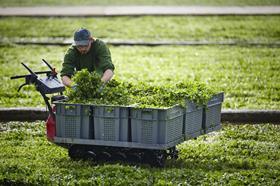
Having established production in Spain several years ago, The Watercress Company is now hoping to break into the Spanish market and introduce consumers to the aquatic crop.
The Watercress Company and its Jerez-based sister company Royalcress are hoping to convince Spanish packers, processors and manufacturers of the product’s business potential at the Fruit Attraction trade show in Madrid this October
The company, whose UK home is in Waddock Cross in Dorchester, will be the first stand-alone watercress exhibitor to attend the show in its 11-year history.
Managing director of The Watercress Company, Tom Amery, said: “We regard Fruit Attraction as a huge opportunity for our Spanish-grown watercress.It gives us and our colleagues at Royalcress the chance to talk directly to packers, processors and manufacturers from around the world but crucially from Spain.
“We hope to introduce them to the health benefits and versatility of watercress to encourage sales and for them to appreciate the huge business potential it has to offer.
“Spain possesses one of the largest areas of watercress production in mainland Europe with three significant growers in the Andalusian region, which is renowned for the flowing spring waters essential for the successful growing of watercress. It’s time that Spain discovers what it has growing on its doorstep.”
Watercress has experienced something of a renaissance in the UK over the last 20 years, according to The Watercress Company, and due to its explosion in popularity, the business established farms in Spain to ensure year-round availability in the UK and to explore other markets.
Today, 1.5 million kilos of watercress are grown in Spain, largely for export, not just to the UK but also to Switzerland, Denmark, France, Germany and the Netherlands.
Portugal is another key export market for Spanish-grown watercress and is in fact the second-biggest consumer of the product after the UK. This is largely because in the noughties, in conjunction with Portuguese universities, UK growers carried out research into how eating the plant can help prevent cancer.
Despiteneighbouring Portugal, Spain has yet to embrace watercress, and Fruit Attraction is being viewed as an opportunity to change this and try to boost domestic sales.
The Watercress Company stand will feature displays of fresh watercress for visitors to try, as well as tastings of freshly made watercress smoothies and watercress pesto to demonstrate the versatility of the crop.
In addition, bags of fresh watercress will be available for visitors to take away and try, and watercress farmers will be on hand to discuss how it is grown.
The company will also be referencing scientific studies that have demonstrated links between eating watercress and the prevention of breast cancer, and the prevention of DNA damage during exercise.
While watercress is consumed around the world today – in Australasia, Asia, the Americas and Europe – the peak of its popularity in the UK was during the Victorian era when, according to The Watercress Company, 60 per cent of the population ate it on a weekly basis and there were around 1,000 acres of watercress beds across the country.
Today, only 150 acres remain, concentrated in Dorset and Hampshire, but The Watercress Company is looking to increase this by developing more beds in the UK while maximising sales from its Spanish-owned farms.



